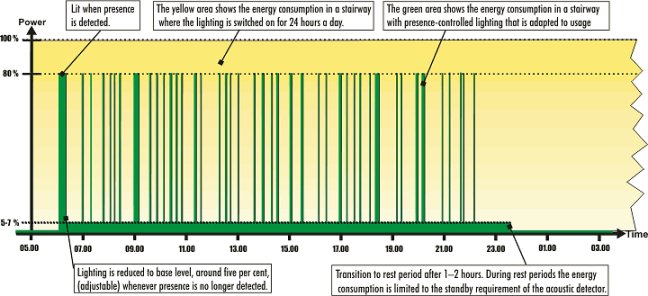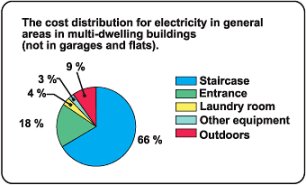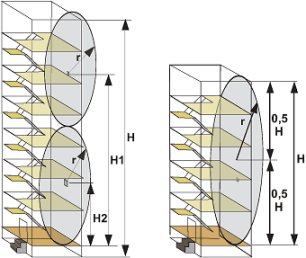4E. Stairway with acoustic detector and incandescent lighting
Svenskt patent nr. 9201493-5, English patent no. 0659329
| Premises
A stairway over five floors can be considered as closed premises with access through a number of doors. This makes acoustic detection an unbeatable solution, as it is the only method that permits lights to be switched on before people enter the premises. In this example the system also provides comfortable and uniform base lighting. Light sources The light fittings in this stairway have standard incandescent bulbs (not low-energy bulbs). Control system NOTE! For acoustic detection it is essential that the stairway is closed, i.e. that all entrances and exits to other areas have doors that are normally closed. This system is adapted for incandescent lighting, and the light level is automatically adjusted to suit the degree of use of the premises. The system gives a high level of convenience, with fast switching on of lights and comfortable, uniform base lighting (5–7 per cent) from all light fittings. It also ensures consistent wear and longer intervals between light source replacement. See the energy diagram on the next page. The system effectively works in the same way as a “Dynamic lighting control” system with fluorescent light fittings and dimmable ballasts. This is described in detail in the manual “Detection technology for improving energy efficiency” and in the brochure “Dynamic lighting control”. This method can be used for both acoustic control and for control with IR detectors. Acoustic detector The acoustic detectors detect sound in two frequency ranges: inaudible infrasound at low frequencies (0–3 Hz) and audible sound at high frequencies (6–8 kHz). These frequency ranges are separated by a frequency range over which the detector is deaf. See the audiogram on the right. There are two versions of acoustic detector: the AD-500 and the AD-600. The AD-500 has a sheet metal enclosure and built-in microphone. The AD-600 has a plastic enclosure for mounting on a DIN rack. An optional light sensor is available that overrides the light system when there is sufficient daylight. See the relevant manual for details of adjustment and programming. See description of operation and wiring diagram below! |
Detector placement
The placement of detectors or microphones is shown in the example below. For more detailed instructions please refer to the manual for the AD500/600. The following is a simple example calculation for the placement of two microphones in a multilevel stairway: H1 = 3 x r H2 = 1 x r r = radius of detection area Note! A similar calculation can be done for the horizontal placement of microphones in a corridor, for example. A wiring diagram is shown on the next page. The microphones, which are wired in parallel, can be connected using EKKX 1 x 4 x 0.25 mm2 cable.
|
||||||||||
|
|
|||||||||||
|
Wiring diagram for application 4E Operation When someone enters the stairway their presence is detected and relays A and B in the acoustic detector close. This closes contactors KA1 and KB, switching on the lighting at the normal level, which is set using dimmer D1. A setting of around 80 per cent is suitable. When presence is no longer detected and the preset delay has elapsed, relay A opens in AD-600. This opens contactor KA1 and closes contactor KA2. Dimmer D2, which is set at around five per cent, is engaged and the lighting is reduced to this base level. If no presence is detected in the stairway for a longer period of 1–2 hours, which is set as the delay for relay output B, contactor KB opens and the lighting is switched off completely for a rest period. The maximum delay that can be set for relay output B is 200 minutes. Information for current budget
|
 |
||||||||||
| Stairway lighting control with automatic adjustment based on usage
The yellow area represent the energy consumption in a stairway where the lighting is switched on for 24 hours a day. A timer could be fitted to switch off the lighting for a few hours during the night. |
The green area represents the energy consumption with lighting control. |
||||||||||
 |
|||||||||||










